Its interesting that there is a relatively large Singapore community in Northfield Minnesota in Carleton College since it is quite an isolated place according to the college website. Anyway, the Singapore club there organised a screening of Singapore GaGa and Invisible City, where according to the organiser Wayne Soon, they put up a valiant effort to articulate Singapore and our propensity for amnesia, which turns out not to be so particular to Singapore after all. He said, “Some in the audience prefer Singapore Gaga but I think the majority like Invisible City. It was interesting how we moved from a discussion of Singapore to similar films by other filmakers done on South Koreans’ recent history (a film about the Kwangju Massacre) and Chinese’s recent history (Like the PBS film on the 1989 Tiananmen Incident called ‘Gate of Heavenly Peace.”)”. Both films will screen in Cuba shortly and Pyongyang, hopefully.
I will love you tomorrow

Lion City (1960) screens at Old School
Highly recommended for an introduction to the first in a long line of films that tries to be Singaporean. It gives you an idea of what “Singaporean” entailed then. For one, it entailed being a union member because everyone in the film seemed to be going to a union meeting through out. It also (then, and arguably now) entails voting for PAP and of course, living in a HDB flat. The original National Education movie that is precious in its earnestness and awkwardness as it wills itself to be Singaporean.
Reviews by Quah Syren (Mandarin), yawning bread and Jeremy Sing
May 16, 2008 – 9:00 pm (Weekend)
May 17, 2008 – 5:00 pm
May 23, 2008 – 3:00 pm
May 29, 2008 – 3:00 pm
May 30, 2008 – 7:00 pm
Sinema link
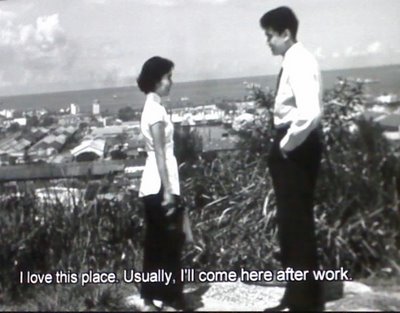
This scene is filmed on Mount Faber taken from Jeremy’s blog
Don’t Touch the Void
Atriums are fast disappearing in Singapore! These are centrepiece voids in the middle of shopping centres and hotels , mainstays in their design that allow you to see all the shops and shoppers, and they you, from whichever floor you are in.
Atriums increase social interaction between shoppers and also between shoppers and the shops. More importantly, it helps shoppers orientate their whereabouts by allowing them to triangulate their co-ordinates.
With the price of real estate soaring, atriums are now a luxury. Shopping centres are filling their atriums by building in them, filling them with�more shops.
Now, you can only see the shop before you, there is no space to roam, cruise around. Shopping is now even more claustrophobic.
Save the Atria!
Picture: Raffles City Shopping Centre gone the way of the dogs.
The Kind Exchange
If you are an Arts Group and need in-kind professional help, eg you need a lawyer to vet your tenancy agreement, please sign onto The Kind Exchange and seek that service
Its in online platform that matches Singapore based professionals who want to volunteer their services to not-for-profit groups. Sort of like e-bay but for services
All you need to do is fill up info on that site to let them know what you need. The more specific you are, the better. If a professional sees your post and thinks he can help, you meet, talk terms out.
Like all good ideas, it is brilliant in its simplicity
Of course, if you are a professional and would like to volunteer your services, as a lawyer, accountant, web designer, please sign up as well.
Please tell all your arts group friends about it. I would really like it to take off. They welcome all not for profits

STUFFS HAPPENIN HERE
Martyn See said today that Speakers’ Cornered (up on You Tube), about the stand off at Speakers Corner during the IMF conference has been PASSED NC16 by the Board of Film Censors (BFC). He submitted it in Dec 2007 and now he’s got an answer.
I had the chance to see it at a recent screening and I have to say that anyone studying Singapore must watch it. Infact I encourage schools to show it as part of National Education too. I am not being disingenious. I am just suggesting that its extremely helpful to learn about Singapore by studying Singapore from different lenses. With the NC16 rating perhaps schools can show it, have a discussion about it after.
The Film Act saga is far from over with this BFC decision and it may be premature to say this: I am glad Martyn persisted these past few years. He was called up for interviews every few weeks for 15 months. They confiscated his tapes and camera and when the investigation ended, Martyn continued to make the same sort of films. Any lesser person would have clamped up, shut down and left long ago.
Are the suits are realising that the Singapore Brand needs serious work. Adrian Belic an American documentarian was in town recently and as I took him around, he said something that shocked me “I don’t understand why people here don’t seem to be in angst, that can’t be right.” He was surprised that most people he had met appeared free. Poor guy, he thought that he was missing out on meeting real people. It was hard to explain to him the concept of a soft authoritarian state. It might be too much like science fiction.
Kerongchong for Pak Bakar
During the Q&A after the screening of Kerongchong for Pak Bakar, Abdul Nizam Hamid the director said he made contact with the cinematographer of P Ramlee’s films Abdul Bakar by sliding letters under the door of his house. In the letter, explained why he wanted to meet Pak Baker. He didn’t deliver the letter himself, he got his wife to do it. Its less threatening I suppose, being petitioned by a woman.
The older Abdul must have been moved and decided to talk with the younger. This film is ostensibly an ode to Mr Bakar, but its more about Nizam, a director wanting, needing to connect with a filmmaker from another era.
This reminds me of the letter I wrote to photographer Marjorie Doggett to ask if I could meet her to interview her. I wrote her two long letters she didn’t reply. One day, one and half years later, we finally met, and the material became an integral part of Invisible City
We seek solace, encouragement from those who have trod on the same paths before us. And like Nizam, we came away not with some specialised knowledge of the craft, but a strong sense of the passing of time.
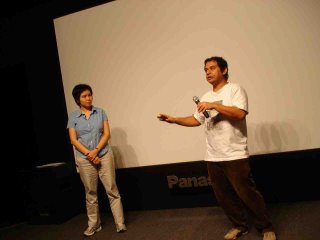
The Q&A at the world remiere of Nizam’s film, with me moderating it
Picture is stolen from a nutshellreview, Stefan’s blog which provides extensive SIFF coverage.
We need SIFF more than it needs us
The 21st edition of the Singapore International Film Festival (SIFF) starts next week. For an independently run and curated film festival to reach its 21st edition is amazing. Even more amazing is what it has done for Singaporeans over the years.
Last year, SIFF’s finances were in dire straits and whether it could make it to the 21st edition was in doubt. When we knew SIFF was having difficulty fundraising, a group of us media professionals came together to help. One of the initiatives was to write a letter to the Singapore Film Commission (SFC) and the Media Development Authority (MDA) to persuade them to increase the funding for SIFF.
Our letter didn’t have much of an effect. Our request to meet them was alas not taken up because it “was not necessary”. The SFC/MDA has made very clear that it is not interested in an independently curated film festival like SIFF. For the 2008 edition, the Singapore Film Commission (SFC) gave SIFF $65,000 (US$40,000).
Still SIFF managed to haul itself out and is now presenting the 21st edition to us, starting on the 4 April with the help of a few individuals, some of whom have been working for the festival for many years.
Everyone, please do not take your independent arts institutions for granted. Please donate, volunteer and support your own festival because if you don’t, no one else will.
Send your cheque addressed to “Singapore International Film Festival Ltd”
Film Festival Secretariat
LASALLE College of the Arts
1 McNally Street #B2-17 (E Block)
Singapore 187940
Tel: 6738 7567 / 6496 5327
Your donations enjoy a double tax exemption status
Here is the full text of the letter we wrote to SFC . Written in November 2007, it was addressed to Mr Man Shu Shum who has since left the position Continue reading
ISEAS screening Wed, 26 Mar 3pm
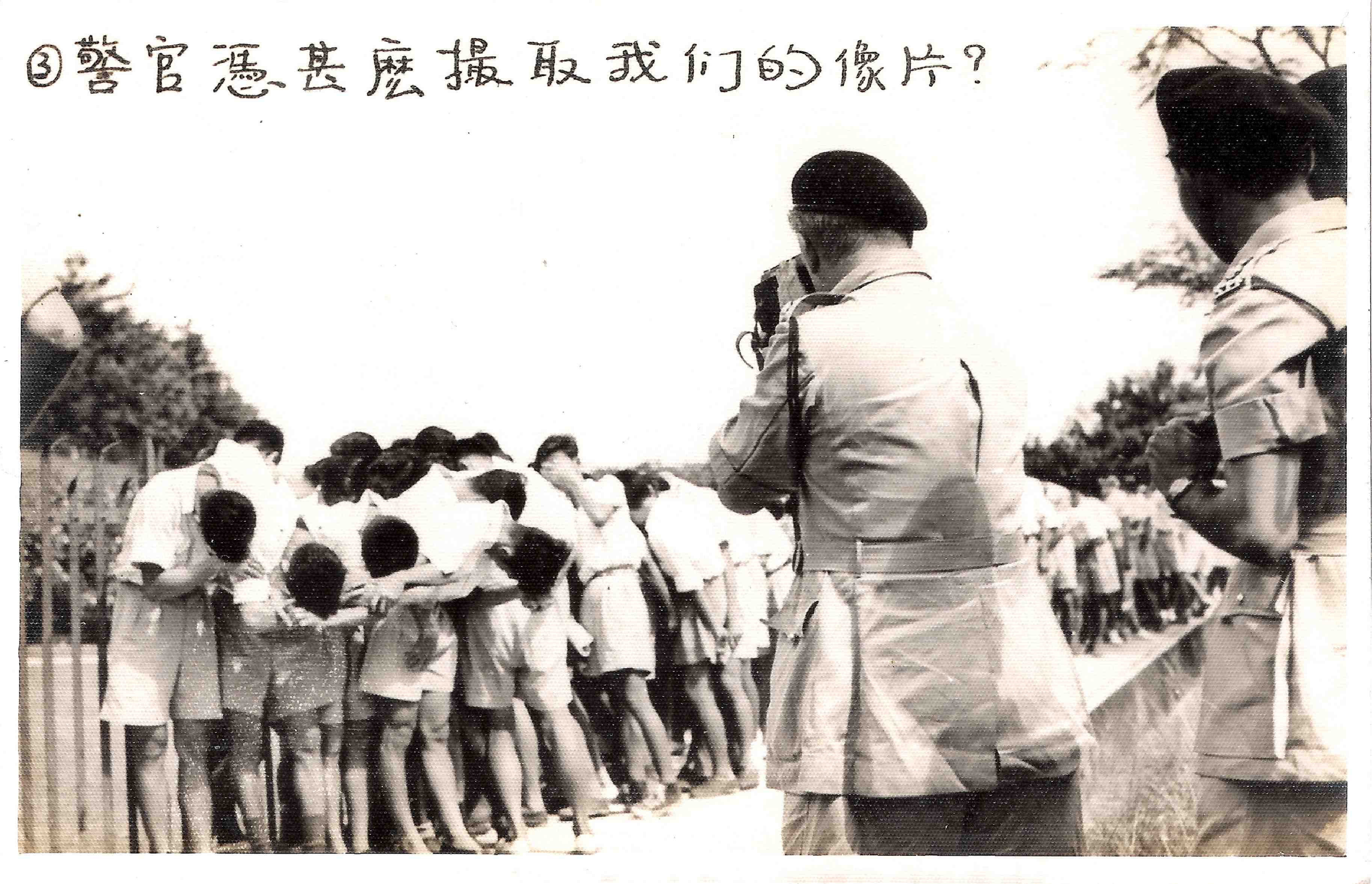
From ISEAS’ programme notes for the screening
“As its name implies, this documentary is about a Singapore that remains invisible, pointing to national consciousness as a fragmented reality with critical bits ignored or demonised. Turning a sharp eye on the subject of memory, the film takes its audience to meet some engaging people struggling to leave a mark before they and their histories disappear: an aging film maker fighting valiantly against time and fading memory to catalogue his treasure trove of rare old footage of the island; an aggrieved student activist from the 1950s wanting to set the record straight for history; etc. In turn poignant, indignant and thought-provoking, the film invites debate about how the past can be remembered and history written, objectively, without fear or favour.”
Invisible City is the second film funded by the ISEAS
A Q&A with the film-maker will follow the screening chaired by ISEAS Fellow Dr Hui Yew-Foong.
Date: Wednesday, 26 March 2008
Time: 3.00 pm to 5.00 pm
Venue: ISEAS Seminar Room II
Please complete the attached Reply Form and return by fax: 6775-6264/6775-6259 to the Institute of Southeast Asian Studies or email: betty@iseas.edu.sg. For further enquiries, please call Betty at Tel: 6870-2472/6778-0955.
INVISIBLE CITY WINS
le Prix international de la Scam at the Cinema du Reel
The Citation: A witty, intellectually challenging essay on history and memory as tools of civil resistance
Scam? Its a good name for a prize isn’t it?
Its soci�t� civile des auteurs multim�dia, en dehors de son r�le de gestion, a pour mission de d�fendre la cr�ation audiovisuelle ex aequo.
Invisible to whom?
I am often asked about the reception of Invisible City overseas, They are curious if Invisible may be perceived differently from a Singaporean audience. Recently it was shown in Spain, at the Punto de Vista Festival. I received and email for an interview. The questions give you a flavour of the issues Invisible raises for a journalist from a country far removed from ours:
Hello Pin Pin
– How do you like to introduce yourself? As a filmmaker or as an artist?
– Why do you prefer, as a filmmaker, the documentary cinema?
– Why did you choose a digital format?
– Although in “Singapore GaGa” the City already acquired protagonist, in “Invisible City” the stories create the emerging of an another vision of the history of the island. Which was the point to begin with?
– At a specific moment, an archaeologist claims that if the camera were not present, its discovery would not exist. Do you think that the televising and cinematographic image today is considered as the only source of veracity?
– Morally, are we forced to recover and to protect politician, social and cultural past?
– Forgetting seems one of the blights of our society. Who are the guilty ones of this situation? Are the institutions? Are the mass media? Are Us?
– When Mr Han talks to the students about his past as activist, they seem not to understand the meaning of their story showing the lack of interest.
– Since its premiere in Pusan, which is the attitud of the public and critic towards the film?
. “Invisible City” is part of the Asian Network of Documentary program. Which is the situation of the documentary cinema in Asia?
– The case of the new Film Act in Thailand and the actions of the Free Thai Cinema Movement impelled by Apichatpong Weerasethakul are significant. Which is the situation of the censorship in Singapur?
– Which are, in your opinion, your influences at the time of filming your short movies and movies?
– Which are your future projects?
Thanks!
DAVID L�PEZ GONZ�LEZ
Invisible is reviewed in Spanish here
Invisible in france
Invisible City is screening at Cinema du Reel, in Seoul at Indiespace and at Busan Cinemateque these two weeks. I am unable to attend the screenings. Marie Pierre Duhamel, the director for Cinema du Reel heaved and said that I was the first director to her knowledge who has a film in competition who isn’t present at her own film’s French premiere, she sounded indignant and full of regret. So I am spiritually in France now trying to decipher the French reception of the movie. I came across this review, and using Google’s translator I got this…
If Fronterismo of the young Sofie Benoot ignores all its promises – were missing in the script elements of a purely technical nature of this situation Mexican border it is perhaps not too late to introduce to the rest of his excellent work would read better – Invisible City of Singaporean Tan Pin Pin, on the contrary, showed a mastery didactic. The director convenes in front of his camera archaeologists, journalists, photographers, witnesses to try, not to give substance to a Singapore of the past, but to talk about the challenges and difficulties of such a refund. Characters out of breath say the urgency, the need to transmit anthropological, the duty of truth despite the censorship But also the challenge of trade.
Invisible City has a life of its own now and I can’t keep up with it
SIFF Delights
The new section Singapore Panorama features new Singapore Films. Many documentaries amongst them, catch Diminishing Memories 2, Keronchong For Pak Bakar, Boom Town Beijing, Women who love women and of course Lucky 7 and Homeless FC. There are so many films from such a diverse group of directors and on such a diverse set of topics. A reason to celebrate, that we have enough movies to fill a whole section in a film festival! The screenings are all in Sinema Old School which everyone should check out, its a cool space!
Full list here
Berlinale 2: cheapy award goes to DUSAN MAKAVEJEV
The Cheapy award at the Berlinale was awarded by Cheap Gossip Studio (a Berlin performance collective infused with Los Angeles exiles) to Dusan Makavejev this year. He is (was) a Yugoslavian film director who made WR: Mysteries of an Organism (1971), one of my all time favourite films, others being the Perfumed Nightmare (Philippines, 1977) and McDull, Prince de la Bun (Hong Kong, 2004). WR was shown as part of a tribute to Dusan at Berlin. Dusan, now bent and doddery was present at the screening and while the citation was read out at an informal award ceremoney at the Arsenale Cinema lobby, kept beaming at his wife.
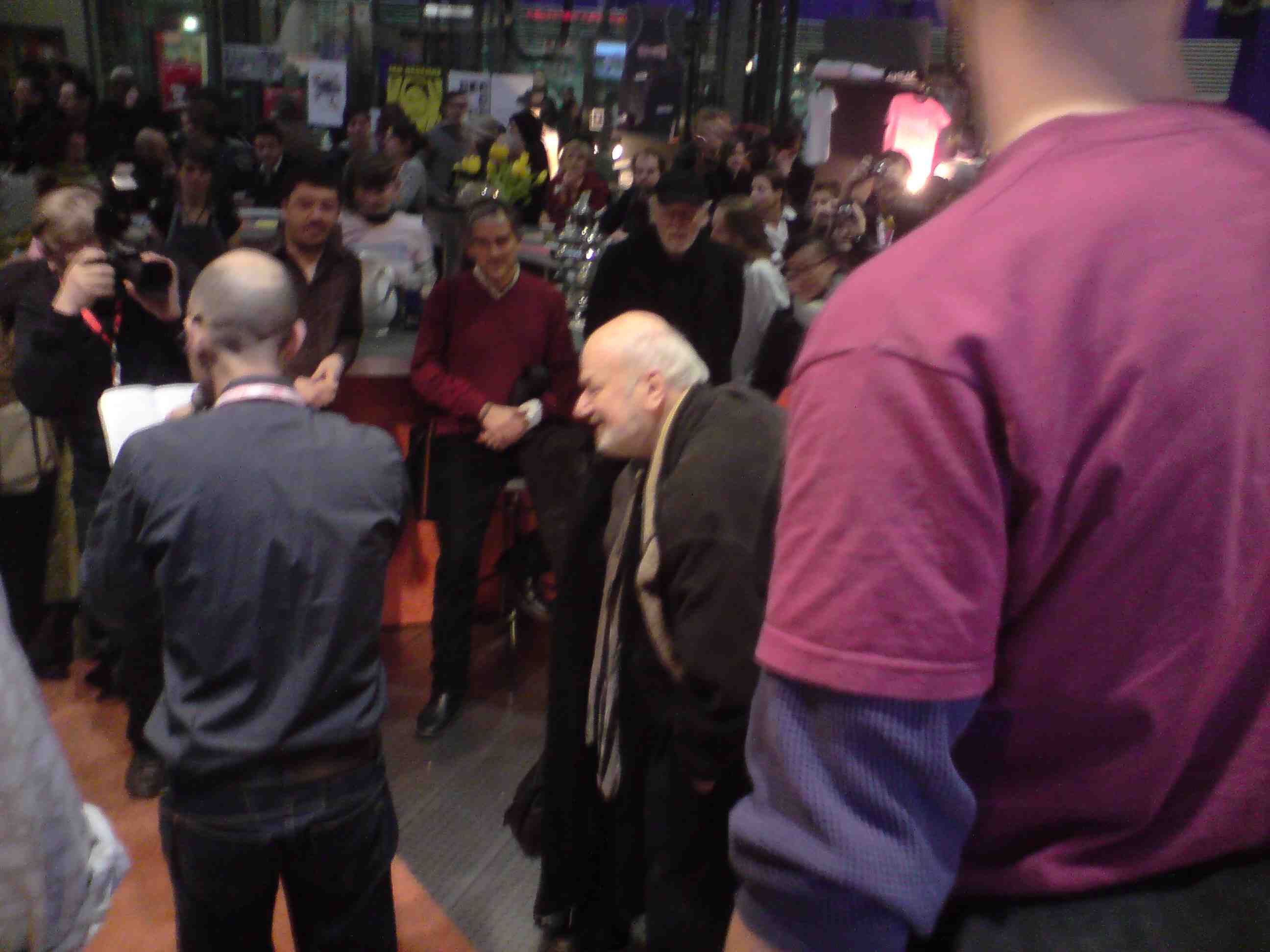
The Citation (courtesy of Marc Siegel):
“DUSAN MAKAVEJEV is a model of joyful, political and aesthetic resistance.
DUSAN MAKAVEJEV’s life and work are marked by a determination to employ whatever narrative and formal strategies he has at his disposal in a struggle for celluloid freedom and shimmery, liberatory desire. Moreover, he does so with humor and joy. For DUSAN MAKAVEJEV recognizes joy, laughter, and erotic desire as political weapons, indeed as tools of resistance, whether one is struggling against pesky, sexless Commies and Capitalies, dour ideologues, or any other sort of institutional stupidity that plagues us all, we good-humored perverts. His movies are sweet with that dark brown taste of intelligent pleasure. They keep us going.
This Award recognizes the singular, but essential talent of hysterical collage, frenzied corporality, and ethical perversion. In other words, this Award acknowledges exceptional aesthetic nourishment in matters of sexuality and politics.
Ladies and Gentlemen, the Ruth Fischer CHEAPy Underground �ber Alles Award for Sexualethik des Kommunismus goes to DUSAN MAKAVEJEV.”
A citation to strive for (the joyfulness part of it anyway). The Eastern European (sorry to lump them together) artists seem able to link sex, politics, resistance and joie de vivre together in a heady mix that that is so much more than a sum of the parts.
Read more about WR here , Criteron has issued a new DVD release
Berlinale 2008
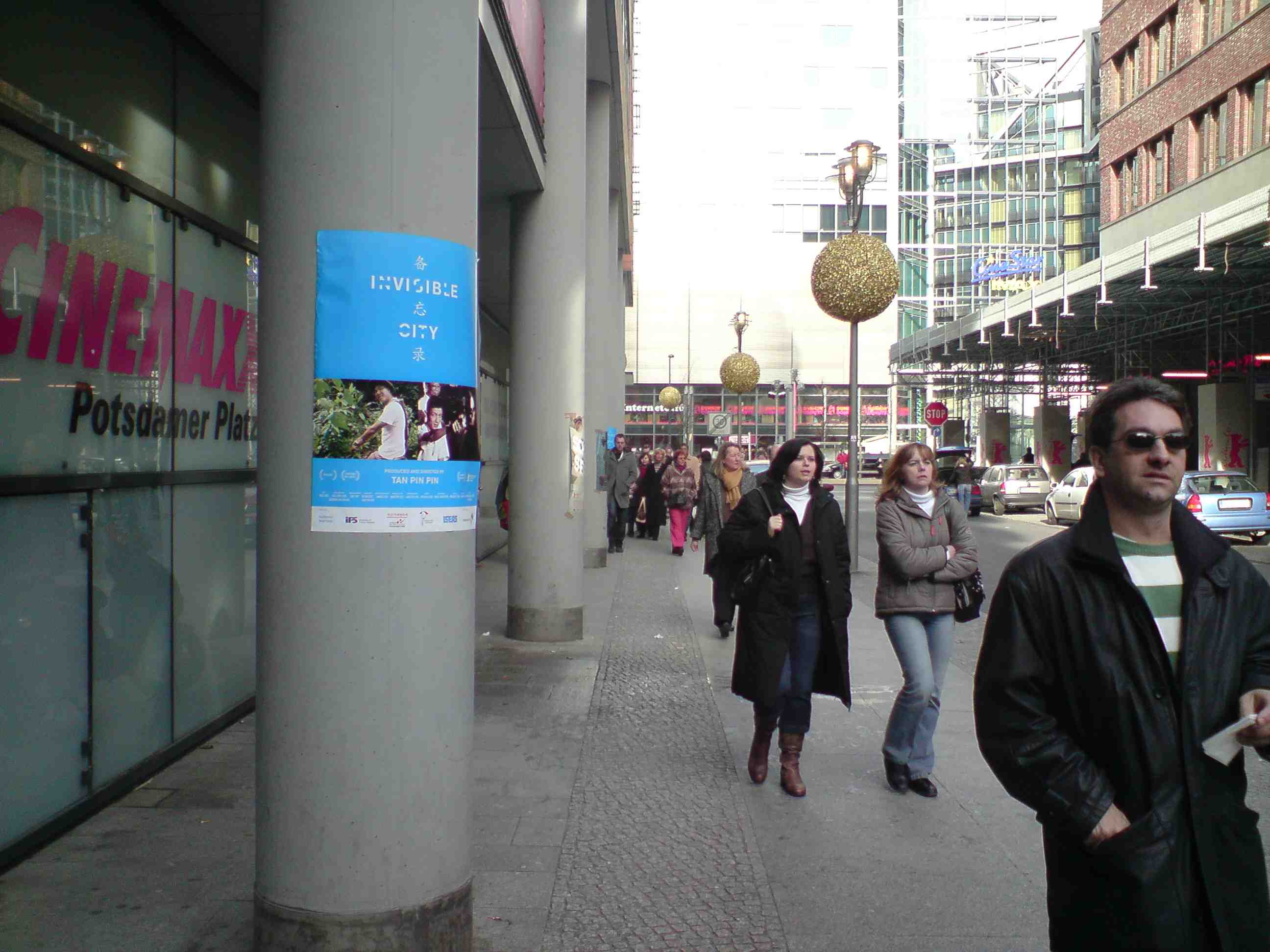
Berlinale is a huge festival consisting of many parts, the monied, the red carpet stars (Rolling Stones opened the festival), the programmers, the film school (Talent Campus), the press, all 1,200 of them. The different ecosystems co-exist cheek by jowl with not much overlap. We worked hard to hop around since it was more comfortable to just settle in one’s own turf, to just hang with our posse
In 7 days, I watched a total of 3 movies, attended 3 Master Classes at the Talent Campus and sat through three of my own screenings. The rest of the time was filled with conversation. Caught between a film and a chat, I found myself choosing the latter, preferring to connect with people rather than projections of them.
Made time though to catch Thai film Wonderful Town. Its director Juk (Aditya Assarat) is an old friend whose work I have been following since 2001. Its now winning prizes all over, garnering rave reviews. Critics hail that they have discovered a new talent. New talent my foot! Juke has been plugging away for more than 10 years and he is finally getting the break he deserves. Wonderful Town opens in France in April. Its a love story set in a post-tsuami Southern Thai town. It is an utterly pleasurable viewing experience, a smoldering and sexy film with not a shot out of place.

I also caught Drifting Flowers (????) by Taiwan director Zero Chou (her Chinese name is more prosaic, ???) who also directed Spider Lillies ?? and Splendid Float (SIFF 2004) I promised Zero that I would be there for her world premiere. It consists of three inter-twined stories about working class T-boys. It wasn’t perfect. At parts it was so melodramatic it was funny. Still, I felt it was made from her heart. Zero knew her audience and this film was for them.
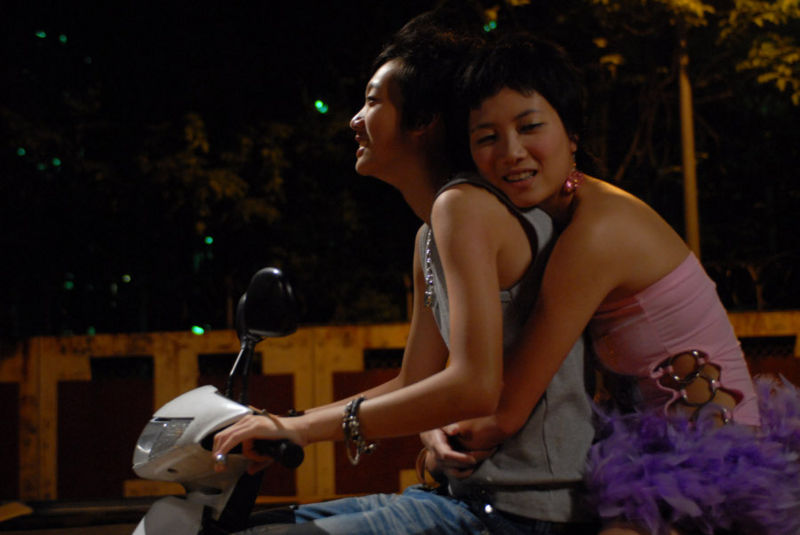
Finally, RR, by James Benning. It consists of shot after shot of trains coming in and going out of frame, the frame unmoving. It is a structural film, a lesson in framing, of using screen space and of pacing. The rhythms and repetition created its own anticipation since there was no plot to speak of. Invisible City was originally set up to be a Benning-esque film of Singapore spaces until I realised that I enjoyed people too much to bear with the solitude needed to make a Benning-esque film. Every screening I attended was packed to the gills. For these last two, I had to sit on the stairs.
My own screenings were full. I am bewildered how this came to be (certainly not from our posters which were torn down every time I put them up) Was it because the Forum have been cultivating their audience for 38 years for this kind of fare or Berlinalers really trust their programmers?
The Q&A moderators knew the film inside out and they raised the broad themes of forgetting and the audience latched onto her groove. (how the Japanese cope with the memory of their occupation, the role of Ivan Polunin as a central figure in the forgetting etc). Of course, the irony that Invisible City, about the insurmountable gap between the present and the past, was screening in a glass and steel plaza on top of what used to be no-man’s-land between the east/west Berlin was not lost on me.
The screening facilities were top notch. Before Invisible’s screening, I asked the projectionist not to turn on the lights until the credits ended because there was an epilogue. She looked at me, offended that I should think she might want to do that. “We don’t turn on the lights during the credits here at the Arsenale”, she smiled. I have a strong memory too of the technician who stood by to adjust the audio real time during the screening so that sound levels would be just right.
Too many films I did not catch, people I did not meet
My last day, Oi Leng suggested that we take a tram, any tram all the way to nowhere. So we hopped onto the M4 tram and took it all the way to an East Berlin burb. This is a shot from the top floor of a block of public flats. It was a wintry day
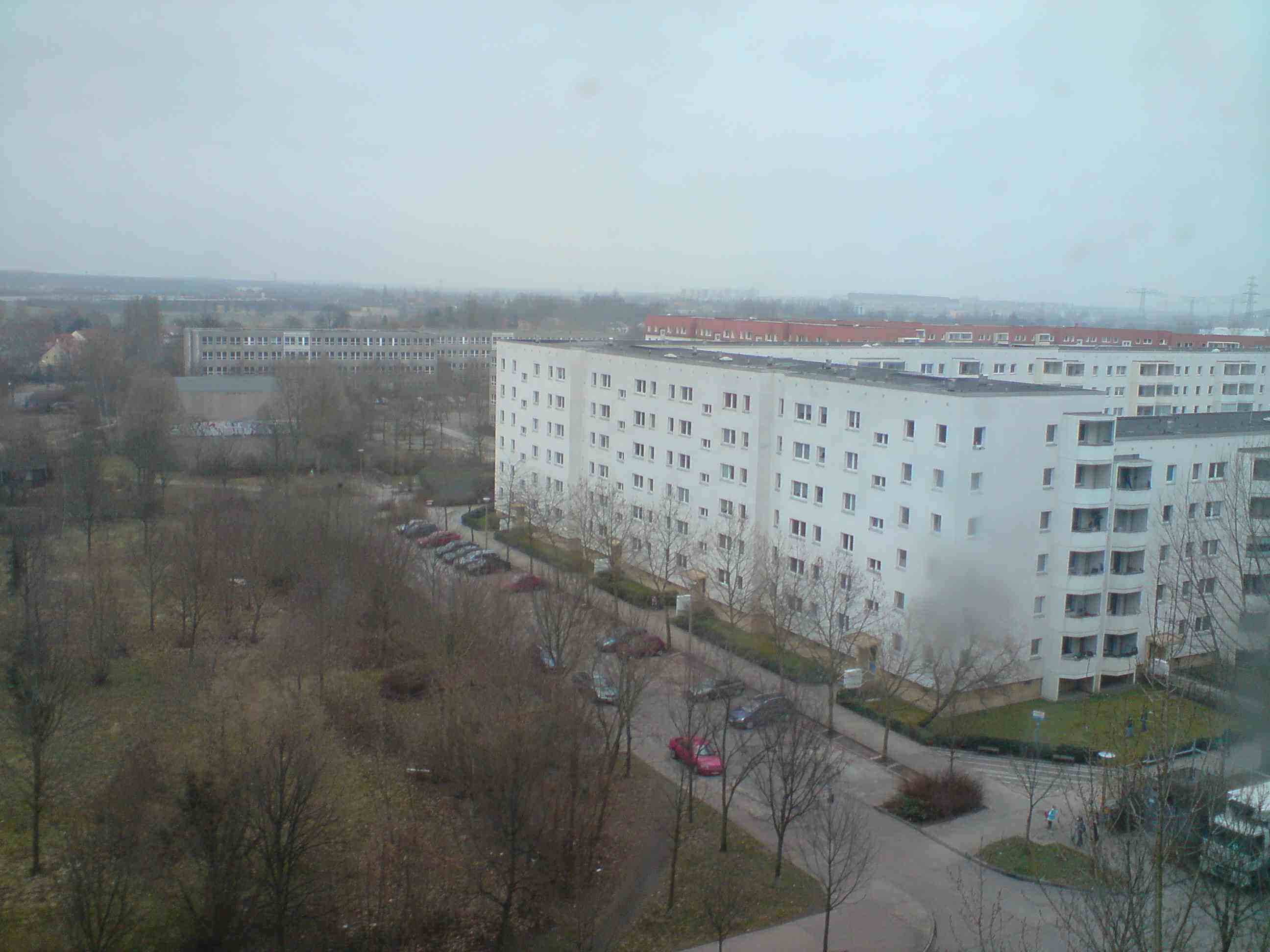
Don’t jump
Singaporeans in Berlinale
Filmmakers going: Anthony Chen (Haze), Tan Siok Siok (Boomtown Beijing), Lillian Wang (Talent Campus).
Distributors Gilbert Lim, Yuen Ping?, Thomas Chia and journo Douglas Tseng on a junket
I think the papers missed this. Eva Tang’s short film Londres-London won The Akira Kurosawa Memorial Short Film Competition Award and Han Yew (“Unarmed Combat”) Kwang won the Audience Award at Lyon’s Asian Film Festival for his short 18 grams of Love. Wow Audience Award.
Invisible City screens at the Bangkok Fringe Festival today as part of a Southeast Asian film programme curated by Chalida. Read in the Nation what she has to say about the programme
“Undeniably, there has been a phenomenal awareness on the international film festival circuit of independent film-makers from Southeast Asia. Names like Apichatpong Weerasethakul, Garin Nugroro and Lav Diaz are no longer strangers. In this program, I would like to introduce the next wave. They are names that might not be too familiar today, but you will hear more and more of them in the near future.” More
At Berlin, I would like to catch James Benning’s RR (after reading so much about his films, I should see it), Aditya’s Wonderful Town which I missed at Pusan,� Bunuel on film for a change. I hear Bruce La Bruce is screening or did I imagine that?
DV filmmaking
Did an email interview for slashcam.de, the biggest German online-magazine on DV / techniques / independent film who is presenting a Berlin International Film festival special at www.netlounge-dv.de
1 How would you describe the aesthetics of your film?
I wanted to make an organic film, a film that grew out of the material so Invisible City is constructed in the edit. The shooting part of the production of it is merely a way to find out what I really want to say. The editing part fine tunes the message
So I shoot a lot by gut, shooting all kinds of things, everywhere. When I have amassed enough footage (How much is “enough”? Its enough when a deadline says I need to stop) I start editing with the editor Inez Ang to make sense of the footage . She is a daring woman to take on the morass. If a framework or a pattern emerges and I feel I need more of one kind rather than another kind of footage – I shoot some more of that kind. The shooting ratio is high, 60:1. DV is the only way I can afford to do this.
2 Why did you choose to shoot on a digital format (was it solely for financial reasons, or did aesthetics play a role)?
Cost is an important issue, but ease of use is another. The camera I use has to be light. Often in the shoot, its just me with with the camera and tripod because the budget cannot afford an assistant all the time. If I had to fiddle with a 16mm camera, loading it, unloading it, I am not sure if I will have the energy left to edit. The money we saved with having less manpower was spent on having more time to look for material, for research and more editing time. Our editing lasted 6 months, interspersed with more shooting.
DV enabled me to find a story.
I shoot in video also to show others that if they are so inclined, they can shoot a video for themselves because it is affordable. I want to eliminate the elitist tenor of filmmaking that is attached to the film format.
Also because of the affordilbility factor, I have a lot of independence to decide what to shoot. This is important to me at this stage in my career. I wanted to find out what themes were germane to me without the influence of commercial pressures. The themes are not as obvious as one would imagine. I could only find out through making these films. Invisible City, Singapore GaGa, 80kmh and Moving House are the result of this search.
That said, I wish I could shoot Invisible City in the film rather than DV format. For this documentary more than any other because Invisible City is about remembering and memories. There is no better archival format than film. The film format will last beyond my lifetime and this would match the themes of the docu. Goodness knows if my Digital Beta master tape can last the next 10 years!
3 Which format exactly did you choose (MiniDV, DVCAM, HDV, HD…), and why?
I shot Invisible City with a Sony PD150 DV Cam which I own and have used since 2001. I think it is time to retire it, to check out the new HD babes. But I am too attached to this workhorse and I am too sentimental.
4 What was special about shooting digital (e.g. compared to 35mm, was it your first time with (H)DV / HD or are you used to it ..)?
I miss the discipline of shooting in film. Shooting in DV is extremely chaotic, there are too many tapes, and too many badly framed shots and badly recorded sound. All this makes it a hell to log and transcribe. One needs to be more organised in a DV shoot than one imagines!
5 What was your shoot-edit ratio?
For Singapore GaGa, it was 40:1
For Invisible City it was 60:1
6 One good word about DV / HDV / HD (or two):
Fast, cheap
7 One bad word about DV / HDV / HD (or two):
Out of control
8 Which camera and editing software did you use?
FCP because editor Inez Ang has that in her suite
Picture by ampulets
Longest Q&A
I recently screened Invisible City at the NUS History Department’s historiography class made up of 4th years and masters students. Small screening, about 60 people. The Q&A turned out to be longer than the film, 90 min long, my longest. They kept coming at me, like raptors, and I had to fend for my life. me vs Them. Becareful those history students, they are merciless.
Citizen Historian �Experiencing Invisible City as a history student�
Documentary Pitch Competition
During JIFFEST, one of my duties was to judge a documentary pitch competition. The winner gets 5000 Euro to finish her project given out by the Jan Vrijman Fund. Seven very earnest directors presented their project to a committee of three. Each director had 20 minutes. In the end we chose 2 projects that we felt had the best chance of being finished: the director had passion, the research was deep, plus he had access to his subject matter. Two teams received 2500 Euros each. Its not much, but some. The pre pitch workshop was conducted by Leonard Helmrich. I hope those documentaries will be made
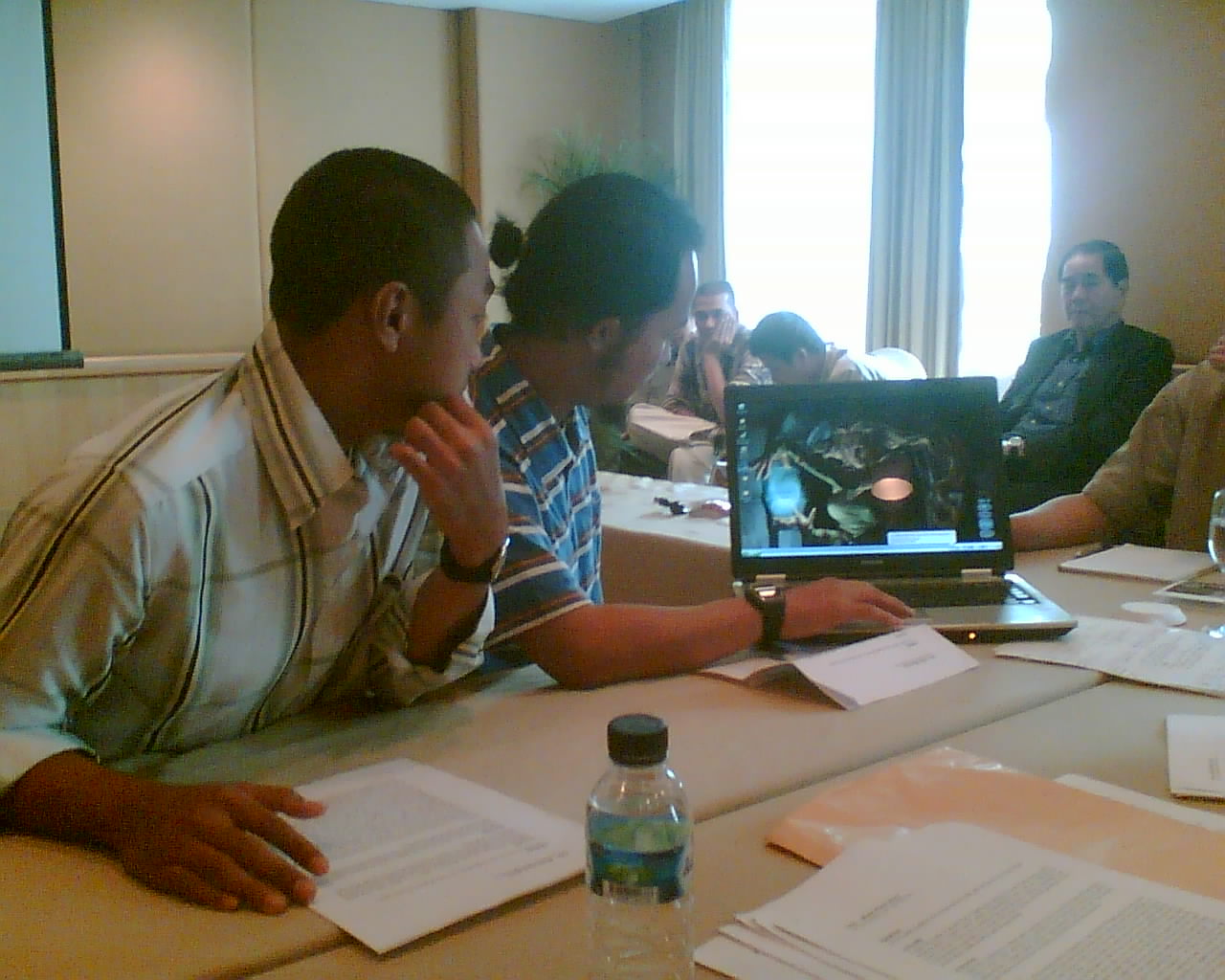
One of the teams showing us a short clip of their intended subject



